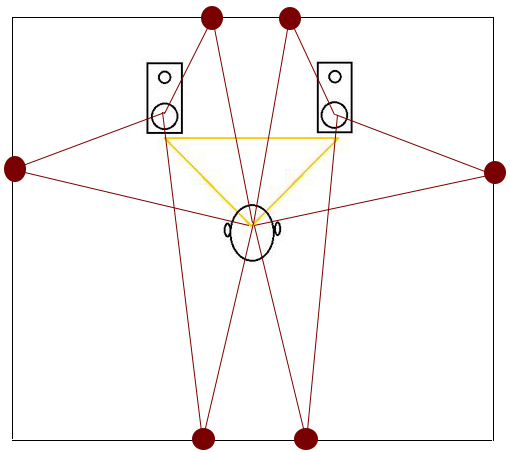- AUDIO ONE-TO-ONE Call Now: 210-805-9927
- Contact
- Register
- My Account
INSTANT SOUNDSTAGE IMPROVEMENT
Our ear/brain aural system localizes sound based on arrival time. Ideally we want to focus on the sound coming directly from the loudspeakers so all the spatial cues in the recording can be aurally processed, giving us the most developed sense of space and localization the music has to offer. When reflections from surfaces nearby arrive at our ears slightly behind the direct sound from the loudspeakers, our brain become “confused” and skews our perception of the recording. This is usually manifest as a blurring of the soundstage or reduction in the focus and ability to localize instruments or players within the soundstage. Eliminating these early reflections can have a profound effect, dramatically improving the dimensional presentation.
Finding the early reflection points is quite a simple procedure. You’ll need a helper, handheld mirror and some masking tape to mark the points. With one person in the listening chair, the other should hold the mirror flat against the side wall at about ear height and slowly move the mirror along the wall (starting at the rear of the room and moving forward). The person in the listening position will see a reflection of the speaker at various points along the way. These are points of reflection, with the closest ones to the speaker producing the earliest reflections, and we call these first reflection points and are the most deleterious and most important to eradicate. You willl also be able to find secondary and tertiary reflection points as well, which can also be treated for further benefit.
Now that you’ve located the points of early reflection, we need to treat them. We do this by using either absorption or diffusion. Absorption essentially kills the reflection, diffusion deals with it by scattering the sound. Which is best depends on a number of factors such as budget, esthetics and the relative acoustical ambience of the room. Looking at the last consideration first, a very “live” (room consisting of mostly hard, reflective surfaces) might suggest absorption to reduce some of the acoustical energy in the room, while diffusion may be more appropriate in a “dead” room (many soft or absorptive surfaces). The two solutions look different as well, so the room decor or esthetic (or your significant other) may play a role in your decision. Finally, cost, and there can be wide variation here as well, so look at the number of reflection points you want to treat to determine what options best fit your budget.
Manufacturers we’ve used with great results include Acoustic Sciences Corporation and the diffusion products from RPG. A favorite here has been the Wall Panels from Acoustic Sciences. These are simple, lightweight absorptive panels that are easily hung on a wall with a single nail or a picture hanger. They are visually unobtrusive in most rooms, do a very good job of quelling reflections and are fairly cost effective. A variety of acoustic foam products, such as those from Sonex, are available as well, however they must be used judiciously as too many of these panels can quickly reduce the natural ambience in a space resulting in an overly dead room.


